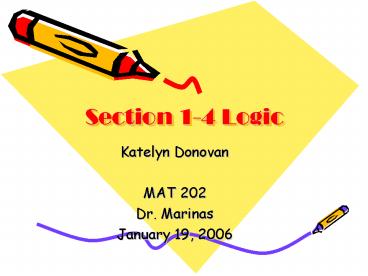Section 1-4 Logic - PowerPoint PPT Presentation
1 / 16
Title:
Section 1-4 Logic
Description:
T T Ariel kisses Eric; she will remain T human. T F Ariel kisses Eric; she does not remain F human. F T Ariel does not kiss Eric; she remains human. T ... – PowerPoint PPT presentation
Number of Views:16
Avg rating:3.0/5.0
Title: Section 1-4 Logic
1
Section 1-4 Logic
- Katelyn Donovan
- MAT 202
- Dr. Marinas
- January 19, 2006
2
What is a Statement?
- A statement is a sentence that is either true or
false, but not both. - Which of the following are statements?
- Lauren has blue eyes.
- Bush is the best president.
- He smells.
3
How did you do?
- 1 is a statement since Lauren was identified as
the person with blue eyes. - 2 is not a statement because it can be true and
false, depending on who you ask. - 3 is not a statement because the he who smells
is not identified.
4
What is a Negation?
- The negation of a statement is a statement with
the opposite truth value of the given statement. - If a statement is true, the negation is false and
if a statement is false, the negation is true. - Ex. Statement It is raining now.
- Negation It is not raining now.
5
Truth Tables
- Truth tables are used to show all possible
True-False patterns for statements. - The symbol p represents a statement and the
symbol p (read as not p) represents a
negation. - The Truth Table for p and p is shown below.
Statement p Negation p
T F
F T
6
Compound Statements
- Compound Statements are two statements with a
connector such as and/or. - The symbol represents and.
- The symbol v represents or.
7
Conjunction
- A conjunction is a compound statement formed by
joining two statements with the connector AND.
The conjunction "p and q" is symbolized by p
q. A conjunction is true when both of its
combined parts are true otherwise it is false. - The Truth Table for Conjunction is shown below
p q p q
T T T
T F F
F T F
F F F
8
Disjunction
- A disjunction is a compound statement formed by
joining two statements with the connector OR. The
disjunction - p or q is symbolized by p V q. The disjunction
is false only when both p and q are false,
everywhere else its true. - The Truth Table for Disjunction is shown below
p q p v q
T T T
T F T
F T T
F F F
9
Conditionals
- Conditionals are statements written as
- if p, then q or p ? q
- Conditionals are also known as implications
- The statement after the if is the hypothesis
and the statement after the then is the
conclusion. - The Truth Table for conditional (implication) is
below
p q p ? q
T T T
T F F
F T T
F F T
10
Example of a Conditional
- IF Ariel kisses Eric, THEN she will remain human.
- p q Conditional
- T T Ariel kisses Eric she will remain
T human. - T F Ariel kisses Eric she does not remain
F human. - F T Ariel does not kiss Eric she remains
human. T - F F Ariel does not kiss Eric she does not
remain T human.
11
Conditionals are written in many ways
- If p, then q
- If p, q
- q, if p
- p implies q
- p only if q
- p is sufficient condition for q
- q is a necessary condition for p
12
Any Implication p ? q has three related
implication statements
- Statement If p, then q. p
? q - Converse If q, then p.
q ? p - Inverse If not p, then not q. p ?
q - Contrapositive If not q, then not p. q ? p
13
Example
- Statement If I am in Miami, then I am in
Florida. (p ? q) - Converse If I am in Florida, then I am in Miami.
(q ? p) - Inverse If I am not in Miami, then I am not in
Florida. (p ? q) - Contrapositive If I am not in Florida, then I am
not in Miami. (q ? p)
14
PROPERTY TIME!
- Equivalence of a statement and its
contrapositive. - The implication p ? q and its contrapositive q ?
p are logically equivalent.
15
Biconditional Statements
- Connecting a statement and its converse with the
connective and gives (p ? q) (q ? p ) - This compound statement can be written as p 1 q
and is read as p if and only if q - This statement is called a biconditional.
p q p 1 q
T T T
T F F
F T F
F F T
16
- HAVE FUN AND GOOD LUCK!
- DO NOT FORGET TO COME SEE ME
- IN THE MATH LAB
- FOR ADDITIONAL ASSISTANCE ?































